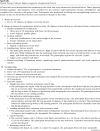Early postoperative measures predict 1- and 2-year outcomes after unilateral total knee arthroplasty: importance of contralateral limb strength
- PMID: 19959653
- PMCID: PMC2802824
- DOI: 10.2522/ptj.20090089
Early postoperative measures predict 1- and 2-year outcomes after unilateral total knee arthroplasty: importance of contralateral limb strength
Abstract
Background: Total knee arthroplasty (TKA) has been shown to be an effective surgical intervention for people with end-stage knee osteoarthritis. However, recovery of function is variable, and not all people have successful outcomes.
Objective: The aim of this study was to discern which early postoperative functional measures could predict functional ability at 1 year and 2 years after surgery.
Design and methods: One hundred fifty-five people who underwent unilateral TKA participated in the prospective longitudinal study. Functional evaluations were performed at the initial outpatient physical therapy appointment and at 1 and 2 years after surgery. Evaluations consisted of measurements of height, weight, quadriceps muscle strength (force-generating capacity), and knee range of motion; the Timed "Up & Go" Test (TUG); the stair-climbing task (SCT); and the Knee Outcome Survey (KOS) questionnaire. The ability to predict 1- and 2-year outcomes on the basis of early postoperative measures was analyzed with a hierarchical regression. Differences in functional scores were evaluated with a repeated-measures analysis of variance.
Results: The TUG, SCT, and KOS scores at 1 and 2 years showed significant improvements over the scores at the initial evaluation (P<.001). A weaker quadriceps muscle in the limb that did not undergo surgery ("nonoperated limb") was related to poorer 1- and 2-year outcomes even after the influence of the other early postoperative measures was accounted for in the regression. Older participants with higher body masses also had poorer outcomes at 1 and 2 years. Postoperative measures were better predictors of TUG and SCT times than of KOS scores.
Conclusions: Rehabilitation regimens after TKA should include exercises to improve the strength of the nonoperated limb as well as to treat the deficits imposed by the surgery. Emphasis on treating age-related impairments and reducing body mass also might improve long-term outcomes.
Figures





References
-
- Cushnaghan J, Bennett J, Reading I, et al. Long-term outcome following total knee arthroplasty: a controlled longitudinal study. Ann Rheum Dis 2009;68:642–647 - PubMed
-
- Hawker G, Wright J, Coyte P, et al. Health-related quality of life after knee replacement. J Bone Joint Surg Am 1998;80:163–173 - PubMed
-
- Fortin PR, Penrod JR, Clarke AE, et al. Timing of total joint replacement affects clinical outcomes among patients with osteoarthritis of the hip or knee. Arthritis Rheum 2002;46:3327–3330 - PubMed
-
- Lingard EA, Katz JN, Wright EA, Sledge CB. Predicting the outcome of total knee arthroplasty. J Bone Joint Surg Am 2004;86:2179–2186 - PubMed
-
- Mizner RL, Petterson SC, Stevens JE, et al. Preoperative quadriceps strength predicts functional ability one year after total knee arthroplasty. J Rheumatol 2005;32:1533–1539 - PubMed
Publication types
MeSH terms
Grants and funding
LinkOut - more resources
Full Text Sources
Medical

